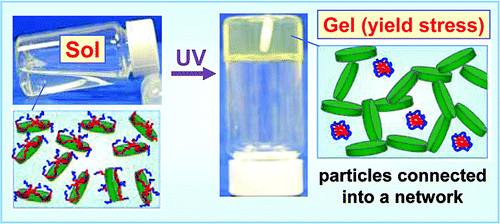当前位置:
X-MOL 学术
›
J. Am. Chem. Soc.
›
论文详情
Our official English website, www.x-mol.net, welcomes your
feedback! (Note: you will need to create a separate account there.)
Photogelling Colloidal Dispersions Based on Light-Activated Assembly of Nanoparticles
Journal of the American Chemical Society ( IF 14.4 ) Pub Date : 2009-05-27 , DOI: 10.1021/ja9008584 Kunshan Sun 1 , Rakesh Kumar 1 , Daniel E. Falvey 1 , Srinivasa R. Raghavan 1
Journal of the American Chemical Society ( IF 14.4 ) Pub Date : 2009-05-27 , DOI: 10.1021/ja9008584 Kunshan Sun 1 , Rakesh Kumar 1 , Daniel E. Falvey 1 , Srinivasa R. Raghavan 1
Affiliation

|
Photorheological (PR) fluids, i.e., fluids whose rheology can be tuned by light, have been a recent focus for our laboratory. We are interested in low-cost approaches to PR fluids using molecules or materials that are readily available. Toward this end, we report a new concept for such fluids based on light-activated assembly of nanoparticles into a physical network (gel). Our system consists of disk-like nanoparticles of laponite along with a surfactant stabilizer (Pluronic F127) and the photoacid generator (PAG), diphenyliodonium-2-carboxylate monohydrate. Initially, the nanoparticles are sterically stabilized by the surfactant, and the result is a stable, low-viscosity dispersion. Upon UV irradiation, the PAG gets photolyzed, lowering the pH by approximately 3 units. In turn, the stabilizing surfactant is displaced from the negatively charged faces of the nanoparticle disks while the edges of the disks become positively charged. The particles are thereby induced to assemble into a three-dimensional "house-of-cards" network that extends through the sample volume. The net result is a light-induced sol to gel transition, i.e., from a low, water-like viscosity to an infinite viscosity and yield stress. The yield stress of the photogel is sufficiently high to support the weight of small objects. The gel can be converted back to a sol by increasing either the pH or the surfactant content.
中文翻译:

基于纳米粒子光活化组装的光凝胶胶体分散体
光流变 (PR) 流体,即流变学可以通过光进行调节的流体,已成为我们实验室最近关注的焦点。我们对使用现成的分子或材料的 PR 流体的低成本方法感兴趣。为此,我们报告了一种基于纳米粒子光激活组装成物理网络(凝胶)的流体的新概念。我们的系统由合成锂皂石的盘状纳米颗粒以及表面活性剂稳定剂 (Pluronic F127) 和光酸产生剂 (PAG)、二苯基碘鎓-2-羧酸盐一水合物组成。最初,纳米粒子被表面活性剂空间稳定,结果是稳定的、低粘度的分散体。在紫外线照射下,PAG 被光解,将 pH 值降低约 3 个单位。反过来,稳定表面活性剂从纳米颗粒圆盘的带负电荷的表面上移开,而圆盘的边缘变成带正电荷。从而诱导粒子组装成一个三维的“纸牌屋”网络,该网络延伸穿过样品体积。最终结果是光诱导的溶胶到凝胶的转变,即从类似水的低粘度到无限的粘度和屈服应力。光凝胶的屈服应力足以支撑小物体的重量。通过增加 pH 值或表面活性剂含量,凝胶可以转回溶胶。最终结果是光诱导的溶胶到凝胶的转变,即从类似水的低粘度到无限的粘度和屈服应力。光凝胶的屈服应力足以支撑小物体的重量。通过增加 pH 值或表面活性剂含量,凝胶可以转回溶胶。最终结果是光诱导的溶胶到凝胶的转变,即从类似水的低粘度到无限的粘度和屈服应力。光凝胶的屈服应力足以支撑小物体的重量。通过增加 pH 值或表面活性剂含量,凝胶可以转回溶胶。
更新日期:2009-05-27
中文翻译:

基于纳米粒子光活化组装的光凝胶胶体分散体
光流变 (PR) 流体,即流变学可以通过光进行调节的流体,已成为我们实验室最近关注的焦点。我们对使用现成的分子或材料的 PR 流体的低成本方法感兴趣。为此,我们报告了一种基于纳米粒子光激活组装成物理网络(凝胶)的流体的新概念。我们的系统由合成锂皂石的盘状纳米颗粒以及表面活性剂稳定剂 (Pluronic F127) 和光酸产生剂 (PAG)、二苯基碘鎓-2-羧酸盐一水合物组成。最初,纳米粒子被表面活性剂空间稳定,结果是稳定的、低粘度的分散体。在紫外线照射下,PAG 被光解,将 pH 值降低约 3 个单位。反过来,稳定表面活性剂从纳米颗粒圆盘的带负电荷的表面上移开,而圆盘的边缘变成带正电荷。从而诱导粒子组装成一个三维的“纸牌屋”网络,该网络延伸穿过样品体积。最终结果是光诱导的溶胶到凝胶的转变,即从类似水的低粘度到无限的粘度和屈服应力。光凝胶的屈服应力足以支撑小物体的重量。通过增加 pH 值或表面活性剂含量,凝胶可以转回溶胶。最终结果是光诱导的溶胶到凝胶的转变,即从类似水的低粘度到无限的粘度和屈服应力。光凝胶的屈服应力足以支撑小物体的重量。通过增加 pH 值或表面活性剂含量,凝胶可以转回溶胶。最终结果是光诱导的溶胶到凝胶的转变,即从类似水的低粘度到无限的粘度和屈服应力。光凝胶的屈服应力足以支撑小物体的重量。通过增加 pH 值或表面活性剂含量,凝胶可以转回溶胶。































 京公网安备 11010802027423号
京公网安备 11010802027423号